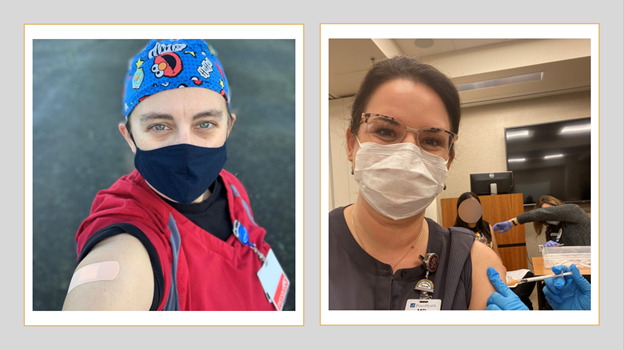Antwon Chavis, a pediatrician with OHSU Doernbecher Children’s Hospital, shares:
“I got vaccinated against COVID-19 because the evidence looked promising that it could help bring an end to the pandemic. Also, the African American community has been disproportionately affected by coronavirus, and I know I am more likely to have a negative outcome than many of my colleagues if I get sick. I believe in vaccines and I believe it’s safe. I wanted my family and my community to see that I trust science, and that vaccinating ourselves is important. I’ve since gotten my second dose. I experienced some mild arm soreness, a little fatigue and a relieved smile from ear to ear. I’m happy to be vaccinated!”
Jessi Cox, an emergency physician in Tillamook (below left), says, “I got vaccinated as soon as I possibly could so we can get the entire world back to school, work and in-person visits!”
Kimberly Ruscher, a pediatric surgeon in Eugene/Springfield (below right), says, “I chose to take the COVID-19 vaccine to help protect our community during this pandemic.”
As we learn more about the rollout of the COVID-19 vaccine in Oregon, we will share details in future newsletter issues and on our vaccine page (English and Spanish).

Testing homes for radon gas remains key
Many people in Oregon are spending more time at home than ever. While our homes are the safest place to stay in order to avoid the spread of COVID-19, there can be risks to being at home.
Many parts of Oregon remain at risk of exposure to high levels of radon, a naturally occurring radioactive gas that comes up from the ground and is drawn into buildings, where it can build up to dangerous levels. Radon is the second leading cause of lung cancer and the leading cause of lung cancer among nonsmokers.
This January, during National Radon Action Month, Oregon Health Authority (OHA) urges people to test their homes for radon. Many test kits are priced between $15 and $25 and can be found in most hardware stores.
The Oregon Radon Awareness Program is offering a free radon test kit to residents whose homes are in ZIP codes where fewer than 20 radon test results have been recorded. Free test kits are available while supplies last.
For more information, including how to order a test kit online, contact the Oregon Radon Awareness Program at radon.program@state.or.us, or visit www.healthoregon.org/radon.
County risk levels updated this week
Governor Kate Brown announced updates to county risk levels under the state’s public health framework to reduce transmission of COVID-19. The framework uses four different risk levels for counties based on COVID-19 spread — extreme, high, moderate and lower — and assigns health and safety measures for each level.
Effective Jan. 15 through Jan. 28, there will be 26 counties in the extreme risk level, two at high risk, two at moderate risk and six at lower risk. A complete list of counties and their associated risk levels is available here.
“With four counties moving back to extreme risk, this week we are reminded that health and safety measures continue to be of utmost importance, even when we slow the spread of COVID-19,” Governor Brown said. “I want to remind all Oregonians to continue to do their part by abiding by the health and safety guidelines in place.”
OHA examines and publishes county data weekly. County risk levels are reassigned every two weeks. The first week’s data provides a “warning week” to prepare counties for potential risk level changes. The next assignment of risk levels will be announced Jan. 26 and take effect Jan. 29. Updates will be posted to coronavirus.oregon.gov.


